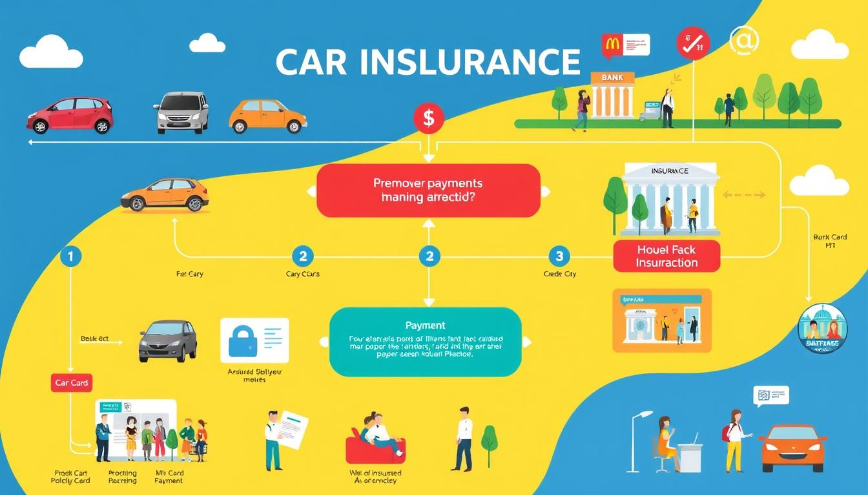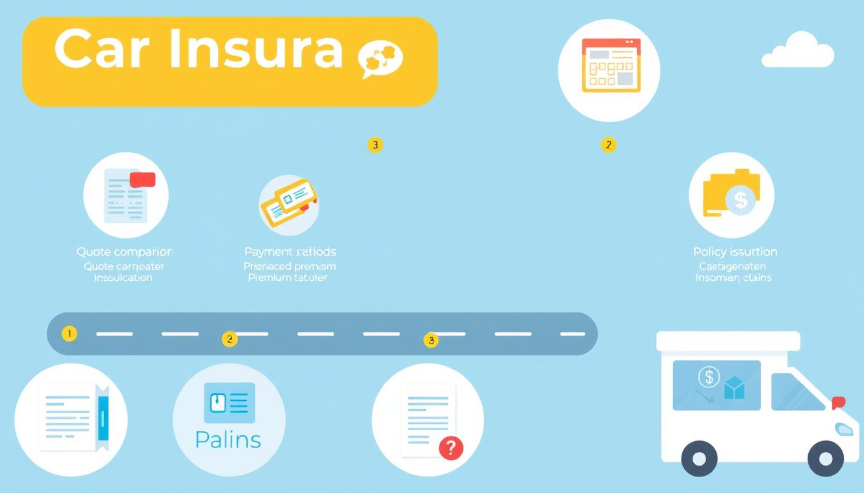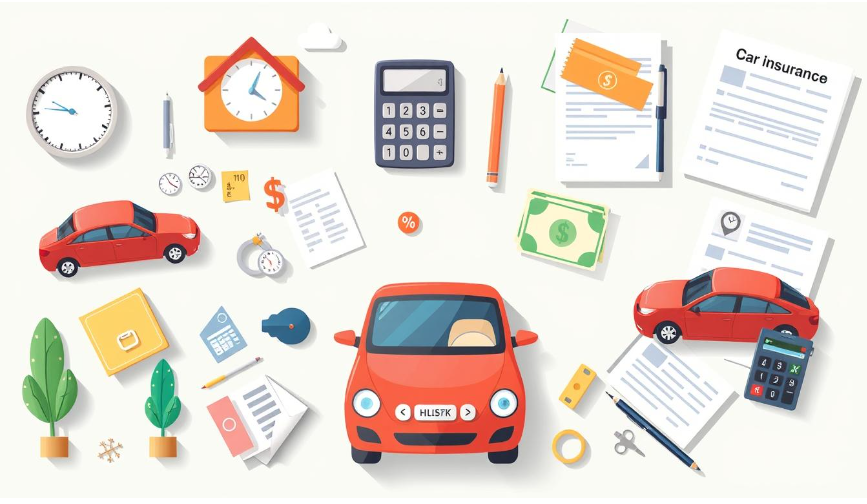Ever wondered what happens when you pay for car insurance? It’s important for car owners to understand. This guide will explain car insurance payments in detail. It will help you understand the terms and processes involved.
We’ll cover why you pay for car insurance, its main parts, and what affects your costs. Learning about these will help you manage your payments better. You’ll know what to expect from your insurance company. Let’s dive into how you can better handle your car insurance payments.
A visual representation of car insurance payments, featuring a stylized infographic layout that illustrates the flow of money from a bank to an insurance company, with arrows showing monthly premium payments, and a depiction of a car in the background symbolizing the insured vehicle. Include elements like coins, a calendar indicating payment due dates, and abstract representations of coverage options to convey the concept clearly and visually engagingly.
Understanding the Basics of Car Insurance Payments
Car insurance payments are key for car owners. They cover several important parts. The basics of car insurance payments include premiums and deductibles. Premiums are the ongoing cost for coverage. Deductibles are what you pay before insurance helps with a claim.
Knowing these terms is crucial for understanding car insurance payment essentials. Choosing the right coverage affects your monthly costs and financial responsibility. Laws in different states set the minimum coverage levels. This affects the policies available and their costs.
Reviewing policy options helps drivers match their insurance to their needs. It’s wise to look at coverage types like liability, collision, and comprehensive. This way, you can find the best balance of protection and cost.

An illustrated scene depicting the essentials of car insurance payments, featuring a variety of car icons, a calculator, dollar bills, and insurance documents arranged harmoniously in a visually appealing layout, incorporating vibrant colors and modern design elements, with subtle representations of concepts like coverage, premiums, and deductibles without any text or characters.
| Term | Definition |
|---|---|
| Premium | The fee paid periodically to keep an insurance policy active. |
| Deductible | The amount a policyholder pays before the insurer covers the remaining costs of a claim. |
| Liability Coverage | Covers damages to other people or property in a situation where the policyholder is at fault. |
| Collision Coverage | Covers damages to the policyholder’s vehicle resulting from a collision with another vehicle or object. |
| Comprehensive Coverage | Protects against non-collision related damages, such as theft or natural disasters. |
How Does Car Insurance Payments Work
It’s key to know how car insurance payments work. At the start, insurers figure out the first payment based on many things. This includes how much coverage you want, your risk level, and details like your car and driving history. This is the start of a payment workflow that lasts the whole policy time.
Payments usually happen every month, every three months, or once a year. You get a bill that shows how much you owe and when it’s due. If you miss a payment, your insurance might stop, so it’s important to pay on time.
When your policy is up for renewal, things change. Insurers look at if anything has changed with you. Then, they figure out a new payment amount and tell you about it.
To make it clear, here’s a table that shows the main parts of car insurance payments and the workflow:
| Phase | Description |
|---|---|
| Initial Payment | First payment made when the policy is taken out. |
| Payment Cycles | Payments are made on a consistent schedule (monthly, quarterly, or annually). |
| Renewal Assessment | Review of policyholder’s information to determine new premium amounts at the end of the policy term. |
| Late Payments | Consequences such as policy cancellation may occur if payments are not received on time. |

A visually engaging flowchart illustrating the process of car insurance payments, featuring a diverse range of vehicles, various payment methods (credit cards, bank transfers), and scenes depicting insurance transactions in a vibrant and informative style, with icons representing policyholders, insurance agents, and financial institutions within a colorful background.
Exploring the Car Insurance Payment Process
The car insurance payment process has several key steps. These steps offer both benefits and challenges for those who have policies. Knowing these steps can make managing payments easier.
The first step is the initial premium payment, which starts the policy. This payment can be made upfront or in installments.
After the first payment, you’ll make recurring payments. These can be monthly or quarterly. It’s important to make these payments on time to keep your coverage active. Missing payments can cancel your policy.
There are different ways to pay, like automatic payments, online, or by mail. Each method affects how smoothly the process goes.
“An infographic-style illustration depicting the step-by-step car insurance payment process, featuring icons representing each stage such as quote comparison, premium calculation, payment methods like credit card and bank transfer, policy issuance, and claims submission. Use a clean, modern design with vibrant colors and clear visual elements to convey understanding.”
Automatic payments make it easy to pay on time, right from your bank account. This keeps your coverage going without interruption. Online payments are quick and easy, with instant confirmation. But, mailing checks might take longer because of the postal service.
Knowing about all the payment options helps you choose what works best for you. Finding a payment plan that fits your budget can make managing your car insurance easier.
| Payment Method | Advantages | Disadvantages |
|---|---|---|
| Automatic Payments | Timely deductions, no need to remember payment dates | Risk of overdraft fees if not adequately managed |
| Online Payments | Immediate confirmation, flexibility in scheduling | Dependent on internet access and digital literacy |
| Traditional Mailing | Simple and familiar for many | Possible delays or lost mail |
Understanding Car Insurance Premiums
It’s key for everyone to understand car insurance premiums. These are the payments you make to keep your insurance active. Knowing how premiums work helps with your budget planning.
Definition of Car Insurance Premiums
A car insurance premium is what you pay to an insurance company for protection. This protection covers you in case of accidents, theft, or other covered incidents. The amount you pay can change based on your risk level and what coverage you need.
Factors Influencing Premium Costs
Many things affect how much you pay for insurance. These include:
- Driving History: A clean record means lower premiums, while accidents can raise costs.
- Location: City living often means higher premiums due to more accidents and theft.
- Vehicle Type: Insuring a luxury or high-performance car costs more.
- Coverage Level: More coverage means a higher premium.
- Credit Score: A good credit score can lower your premiums.
Knowing these factors helps you choose the right coverage and find the best rates. This is important when you’re buying or renewing your insurance.

A visual representation of car insurance premiums, featuring a split scene with a car on one side and a calculator, coins, and policy documents on the other; an abstract background illustrating financial concepts like graphs and percentages subtly blending with automotive imagery, conveying a sense of understanding and clarity in the complexities of car insurance payments.
| Factor | Impact on Premium |
|---|---|
| Driving History | Higher accidents lead to increased costs. |
| Location | Urban areas typically see higher rates. |
| Vehicle Type | Luxury vehicles often incur higher premiums. |
| Coverage Level | More coverage increases the premium amount. |
| Credit Score | Better scores may reduce premium costs. |
Calculating Car Insurance Rates
Learning how to calculate car insurance rates helps you find the right coverage at a good price. Many important factors influence your insurance costs. Knowing these can help you make smart choices.
Key Factors Affecting Rates
Insurance companies look at several things when setting rates. Here are some key ones:
- Age: Young drivers, especially those under 25, often pay more because they’re less experienced.
- Driving Record: A clean record means lower rates. But accidents and tickets can increase costs a lot.
- Credit Score: A good credit score can lead to better rates. Insurers see it as a sign of responsibility.
- Type of Vehicle: The car’s make and model can affect rates. More expensive or high-performance cars usually cost more to insure.
How to Get Accurate Quotes
Getting accurate car insurance quotes takes effort and research. Here are some tips:
- Online Tools: Use comparison websites to see different rates and options from various insurers.
- Direct Inquiries: Contacting insurance companies directly can give you quotes tailored to your situation.
- Consumer Reports: Look at data from consumer reports to learn about average rates and customer satisfaction.
Understanding the factors that affect insurance quotes and using the right strategies can help you confidently find the best rates.
Car Insurance Billing Cycles
Knowing about car insurance billing cycles is key for good financial planning. Most companies let you choose from insurance payment schedules like monthly, quarterly, or yearly. Each choice has its own good and bad points that can change your costs and how you manage money.
Monthly payments are smaller and easier to handle if you’re on a tight budget. But, they might cost more in the long run because of extra fees. On the other hand, paying yearly means a bigger upfront payment but often gets you a discount. This is good for those who can pay all at once.
Quarterly payments are a middle ground. They offer a balance between being affordable and possibly saving some money. It’s important to look at each option carefully to find the best fit for your finances.
| Billing Cycle | Payment Amount | Overall Cost Impact | Ideal for |
|---|---|---|---|
| Monthly | Lower | Higher overall due to finance charges | Those seeking budget flexibility |
| Quarterly | Moderate | Balanced costs, potential small savings | Those needing a middle ground |
| Annual | Higher | Potentially lower total premium with discounts | Those who can pay upfront |
Each choice has its own benefits, suited to different financial needs and likes. Understanding these car insurance billing cycles helps you make a better choice for your situation.
Auto Insurance Installment Plans
Auto insurance installment plans let you pay over time instead of all at once. It’s key to know about these plans to manage your money well. Many insurers offer ways to split your premium into smaller parts. This makes it easier to keep your coverage without breaking the bank.
Understanding Different Payment Plans
Insurance companies offer various payment plans. You might choose from monthly, quarterly, or semi-annual payments. Some plans may have extra fees or interest, so it’s good to know what you’re getting into.
- Monthly Payments: The smallest amount each month, often the most popular choice.
- Quarterly Payments: A bigger payment every three months, which might save on interest.
- Semi-Annual Payments: A balance between monthly and yearly payments, offering long-term savings.
When to Choose an Installment Plan
Installment plans are useful in certain situations. You might want one if:
- You have to manage many expenses and need to control your cash flow.
- The premium is high, making a single payment hard.
- You’d rather put the upfront cash into other investments.
Knowing about auto insurance installment plans helps you make choices that fit your finances. Think about the costs and your budget before picking a payment plan.
Factors Affecting Car Insurance Payments
Many things can change how much you pay for car insurance. Your age, where you live, and how you drive are big factors. Insurance companies use this info to set your rates.
New laws and rules can also change your insurance costs. For example, new traffic laws or insurance rules might make your policy more expensive. Knowing about these changes helps you plan for any cost increases.
Payment influencers go beyond just personal stuff. What kind of car you drive matters too. Cars that cost more to fix or replace can raise your insurance bill. But, cars with safety features might lower your costs.
It’s important to check your policy often. Life events like getting married, moving, or changing jobs might mean you need to update your coverage. Keeping your info up to date helps ensure you’re paying the right amount.
| Factor | Description | Impact on Payments |
|---|---|---|
| Age | Young drivers often face higher premiums due to perceived risk. | Increased costs for younger drivers |
| Location | Areas with high crime rates or traffic congestion may have higher rates. | Potentially increased premiums |
| Vehicle Type | Luxury or high-performance cars usually have higher insurance costs. | Increased costs for certain vehicles |
| Driving History | A clean driving record can lead to lower premiums. | Reduction in costs for safe drivers |
| Policy Changes | Adapting coverage based on life events can affect payments. | Possible increase or decrease in premiums |
Making Car Insurance Payments on Time
Timely payments are key to keeping your car insurance active. They ensure a good relationship with your insurer. Financial advisors say planning and sticking to due dates is crucial for your financial health.
Importance of Timely Payments
There are many reasons why making car insurance payments on time is important:
- Maintains Coverage: Keeps you covered in case of an accident or claim.
- Avoids Penalties: Stops late fees and extra charges from adding up.
- Preserves Your Credit: Helps keep your credit score good by avoiding negative reports.
- Ensures Smooth Claims Process: Makes filing claims easier since only active policies are covered.
Consequences of Late Payments
Not paying on time can cause big problems. These include:
- Policy Cancellation: Your coverage might get cancelled after a grace period, leaving you without protection.
- Higher Premiums: Late payments can lead to higher premiums when you renew.
- Loss of Discounts: Missing payments might mean you lose discounts for continuous coverage.
- Increased Stress: Not knowing if your policy is active can cause a lot of worry, especially after an accident.
Car Insurance Payment Options
Choosing the right car insurance payment options is key to a good experience with your insurer. Many people now face a choice between online payments and traditional ones. Each option has its own benefits and drawbacks, affecting how easy and efficient it is.
Paying Online vs. Traditional Methods
Online payments are getting more popular for car insurance because they’re quick and easy. You can make payments anytime and usually get instant confirmation. On the other hand, traditional methods like checks or money orders take longer and might need a trip to the bank.
- Advantages of Online Payments:
- Immediate processing
- Convenience of making payments anytime
- Access to payment history and policy documents
- Advantages of Traditional Payments:
- Physical record of payment
- No need for online accounts or credit card information
Setting Up Automatic Payments
Setting up automatic payments can make paying for car insurance much easier. By setting up recurring payments, you avoid late fees and ensure coverage doesn’t lapse. This saves you time and hassle.
Many insurers make it simple to set up automatic payments online. Studies show that customers who use automatic billing are happier. This is because it makes managing finances easier.
| Payment Method | Time to Process | Convenience | Customer Satisfaction |
|---|---|---|---|
| Online Payments | Instant | High | Typically High |
| Traditional Payments | 1-10 days | Moderate | Varies |
Managing Your Car Insurance Payments
Managing car insurance payments is key to keeping coverage and avoiding financial stress. Using different tools and strategies helps track payments. This leads to better budgeting and financial health. Here are some tips for managing and adjusting your payments.
Tips for Keeping Track of Payments
- Utilize Budgeting Apps: Use mobile apps for budgeting and finance. They remind you of due dates and track spending.
- Set Calendar Reminders: Set reminders on your digital calendar to alert you before payments are due.
- Review Payment History: Check your payment history often to spot patterns and ensure accurate tracking.
- Regularly Communicate with Your Insurer: Keep in touch with your insurance company to quickly fix any payment issues.
Adjusting Your Payment Strategy
Changing your payment plan might be needed due to financial changes. Consider these points when adjusting your payments:
- Explore Flexible Payment Plans: Insurers may offer plans that fit your budget. Ask about these options.
- Evaluate Your Coverage: If your finances change, review your policy. Choose coverage that matches your current budget and needs.
- Benefit from Discounts: Look for discounts, like bundling policies or a clean driving record. These can lower your payments.
| Payment Tracking Method | Advantages | Considerations |
|---|---|---|
| Budgeting Apps | Convenient reminders and expense tracking | May require a subscription fee |
| Calendar Reminders | Simple and easy to set up | Only useful if adhered to |
| Payment History Review | Helps identify spending patterns | Requires regular attention |
| Insurance Provider Communication | Resolution of payment discrepancies | Requires proactive engagement |
Common Mistakes to Avoid
Dealing with car insurance can be tricky. Knowing the common mistakes in car insurance payments helps avoid big errors. Many people misunderstand their coverage, which can hurt their finances in unexpected ways.
Misunderstanding Coverage Levels
Choosing the wrong coverage level is a big mistake. Some think they’re covered enough, but they’re not. This can lead to big costs if something happens. It’s important to read your policy carefully and talk to an insurance expert to make sure you’re covered right.
Ignoring Policy Changes
Not noticing changes in your policy is another mistake. Insurance companies can change things for many reasons, like new laws or changes in risk. If you don’t keep up with these changes, you might not be covered right. Always check your policy and talk to your agent to stay protected.
Conclusion
Understanding car insurance payments is key for everyone. Knowing how premiums are set and the importance of timely payments helps a lot. It keeps your finances safe and manages risks well.
Reviewing your policy and payment plan often is smart. It makes sure you’re covered right and might save you money too.
Insurance payments need constant attention. The world of car insurance changes a lot. This includes personal stuff, market shifts, and new coverage choices.
Being informed helps you make better choices. It fits with your financial plans. This knowledge makes you more confident and skilled in handling auto insurance.
FAQ
How does car insurance work in terms of payment?
Car insurance payments mainly involve paying a premium. This premium keeps your policy active. You can pay it annually, semi-annually, or monthly, based on your choice.
Understanding car insurance payments means knowing your premium, deductibles, and how they affect your coverage.
What factors affect my car insurance premiums?
Many things can change your car insurance rates. These include your driving history, the car you drive, where you live, and your credit score. Insurance companies use these to figure out how much risk you are.
What are my car insurance payment options?
Insurers offer different ways to pay, like online, automatic bank debit, or checks. Picking the right one makes managing payments easier.
What should I know about car insurance billing cycles?
Billing cycles for car insurance can be monthly, quarterly, or yearly. Each has its own benefits and drawbacks. It’s important to pick the one that fits your budget best.
How can I ensure timely car insurance payments?
To pay on time, set up automatic payments or reminders. Use apps or digital calendars to stay organized. This helps avoid coverage lapses or penalties.
What are the consequences of late car insurance payments?
Late payments can lead to penalties, higher premiums, and even policy cancellation. Keeping up with payments is key to avoid these issues. It helps you get insurance in the future.
What are auto insurance installment plans?
Installment plans let you pay your premium in parts over time. While it might help financially, it often includes interest. Think carefully about this.
What mistakes should I avoid related to car insurance payments?
Avoid mistakes like not understanding your coverage, ignoring policy changes, and missing payment due dates. Knowing these common errors helps manage your insurance better.



